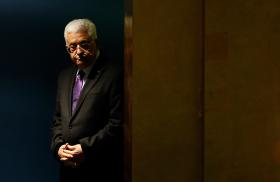

Israel takes no joy in another round of hostilities with Hamas in Gaza, but it is a fight born of necessity.
Ever since Israel unilaterally evacuated Gaza in 2005, Israelis often say that while Israel left Gaza, Gaza never left Israel. I was reminded of this as the Israel Defense Forces (IDF) undertake yet another ground operation to stop the firing of rockets into Israel. For 10 days prior to the incursion, Hamas and other Palestinian armed groups in Gaza fired some 1,400 rockets all over the country, driving millions of Israelis into bomb shelters. Israel tried to stop the rockets through airstrikes, but when Hamas continued to fire and rejected an Egyptian cease-fire proposal, Israel was left with little choice other than a ground operation.
Israel's decision-makers were evidently reluctant to send ground troops. They would have much preferred to achieve their stated goal -- a long, durable cease-fire -- using airstrikes alone. With the Iron Dome rocket-interception system scoring an amazing success rate of about 90 percent, they could afford to give prolonged targeted airstrikes a chance to give way to a mediated cease-fire. The government sustained accusations by some in Israel of hesitancy, yet it remained clear-eyed about the challenge.
Gaza is a densely populated area, with 1.7 million people living in an area of 139 square miles. It is highly militarized, with thousands of rockets and production and storage facilities -- some courtesy of Iran. To make things worse, Hamas purposely nests its military capabilities inside civilian facilities -- the U.N. Relief and Works Agency just announced the discovery of 20 rockets in one of its schools -- and in an intricate web of underground tunnels and bunkers beneath urban areas. Israel did not seek this confrontation, nor does it desire to be drawn into Gaza while facing other strategic challenges in an unstable, hostile environment and with a delicate standing regionally and internationally.
So why did Israel go in after all? Because airstrikes were proving insufficient to pressure Hamas to agree and abide by a lasting cease-fire. Motivating Hamas to do so requires a significant degradation of its military capabilities -- more than can be achieved from the air.
Israel estimates that Palestinian armed factions have so far lost about half of their rockets, yet still possess several thousand more. No less deadly is the threat of Hamas's tunnel network, dug from Gaza into Israeli territory with the aim of detonating explosives under Israeli towns or infiltrating to kidnap or kill citizens. In June 2006, Hamas used such a tunnel to kidnap Israeli soldier Gilad Shalit, for whom Israel later traded over 1,000 Palestinian security prisoners. Hamas has also tried using tunnels in the current round of fighting -- large groups of heavily armed Hamas operatives have repeatedly emerged from tunnels near Israeli villages, intending to attack them. The operatives were killed or driven back, but occasionally managed to kill a number of Israeli soldiers.
Only boots on the ground can deal effectively with these remaining capabilities. But despite the IDF's effectiveness, Israel's current ground operation does not aim to destroy Hamas. This would require the conquest of Gaza for a long period -- and once Gaza's military infrastructure was dismantled, would demand an impossibly problematic exit strategy. Even if Hamas were "destroyed," Israel could face Somalia-like anarchy in Gaza, with numerous armed factions and no clear address to enforce a cease-fire.
Israel's ground operation is therefore limited, focused on targeting rocket-launching capabilities and especially the tunnels, which have become a major threat to Israel.
Lacking a technological solution that would allow it to identify an underground tunnel from afar, Israel has to rely on intelligence, good defenses, and searches on the ground to counter this threat. A number of tunnels were discovered and destroyed over the last few years -- as well as nearly 20 of them during Israel's current ground operation -- and their sophistication sheds some light on Hamas's financial priorities in running the economically dilapidated Gaza Strip. The biggest tunnel, for example, was over 65 feet deep and stretched for over a mile, making use of hundreds of tons of concrete and cement.
Israel's ground operation may require some time to achieve both its operational and strategic objectives. Hamas initiated this round of fighting in a bid to extricate itself from unprecedented political and financial bankruptcy. Its demands for a cease-fire therefore focus on economic and political rewards -- opening border crossings, covering the salaries of its public employees (many of whom belong to its security forces), and the release of prisoners -- designed to consolidate its grip on Gaza. In contrast, Israel seeks to re-establish deterrence by denying Hamas rewards for violence. Egypt's traditional mediating role has met with opposition from Hamas, which is all too aware that Abdel Fattah al-Sisi's government regards Hamas -- the Palestinian branch of the Muslim Brotherhood -- as an enemy.
This unwanted crisis demands Israel make hard choices between unappealing options. Yet it also offers some potential opportunities. Weakening Hamas may ultimately produce a cease-fire arrangement that prevents the remilitarization of Gaza -- with Egypt effectively sealing its border with the territory -- and deters Hamas from using violence. Such an outcome may allow for the opening of Gaza's crossings to extensive humanitarian assistance and economic development channeled through the Palestinian Authority, to the benefit of the people of Gaza rather than Hamas.
Gaza, however, has proved itself resistant to best-case scenarios in the past. But even if the current operation does not deal a decisive blow to Hamas, in this quagmire even a long lull between rounds of fighting is a blessed respite.
Brig. Gen. Michael Herzog, IDF (Ret.), is The Washington Institute's Milton Fine International Fellow and a longtime Israeli peace negotiator and defense official.
Foreign Policy



